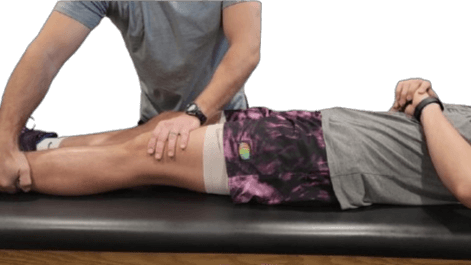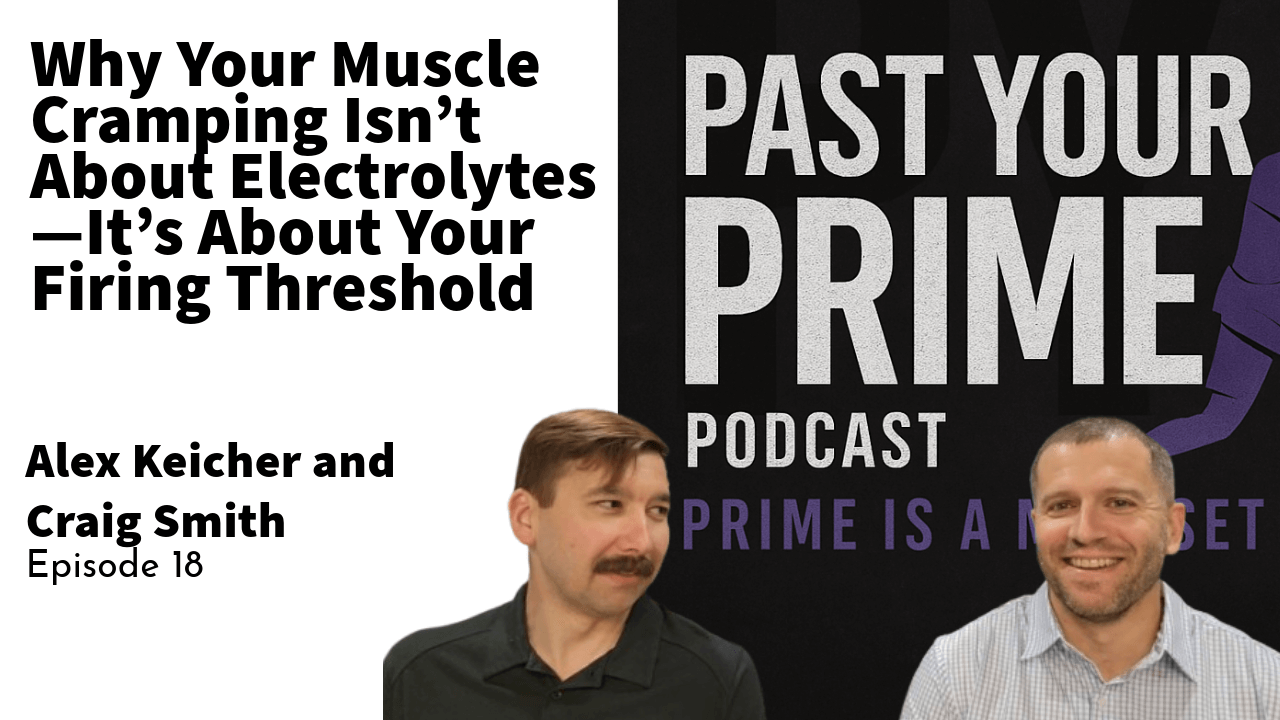Are You Really Treating the Right Cause of Your Knee Pain?
When knee pain strikes, the default response is often “just strengthen your glutes” or “stretch your quads.” But what if the issue isn’t about weak muscles at all?
In Episode 11 of the Past Your Prime Podcast, Craig Smith (physical therapist and strength coach) and Alex Keicher (professional volleyball player, father, and proud owner of enormous calves) dive into a knee injury that frequently goes undiagnosed: anterior horn meniscus lesions.
This episode challenges the usual rehab approach, highlighting why glute strength isn’t always the answer and why proper diagnosis is the key to effective treatment.
Injury Updates: The Usual Suspects
Before diving into the real cause of anterior knee pain, Craig and Alex share their latest injury struggles:
- Craig’s neck pain – Flared up from heavy shoulder pressing, but he’s managing it with traction.
- Alex’s wrist – Slowly improving, but still a work in progress.
- Alex’s triceps pain – A new mystery injury that Google has diagnosed as triceps tendonitis (or possibly just being old, according to Craig).
What Is an Anterior Horn Meniscus Lesion?
When people think of meniscus injuries, they picture soccer players, football players, and quick pivoting movements. While that’s true for some meniscus tears, anterior horn lesions are different.
How Does It Happen?
Unlike traumatic meniscus tears, anterior horn lesions are degenerative. The injury develops over time due to constant compression of the meniscus during normal walking.
Every step you take involves cycles of knee flexion and extension. As you approach full extension, the femur and tibia compress the anterior horn, creating chronic irritation and degeneration.
- This means every step you take could be making it worse.
- Missed diagnoses = failed rehab plans.
Common Signs of an Anterior Horn Meniscus Injury
1️⃣ Pain at the front of the knee (especially in full extension).
2️⃣ Discomfort when locking out the knee during walking or standing.
3️⃣ Pain with passive knee extension (when someone else moves your leg for you).
4️⃣ Sharp pain during leg extension exercises.
5️⃣ A stiff or springy sensation when trying to fully straighten the knee.
If you’re feeling knee pain but haven’t had success with standard rehab, it might be time to look beyond the usual suspects (patellar tendon, quad tightness, glute weakness).
Why This Injury Is So Often Missed
Craig breaks down a major problem in how knee pain is diagnosed:
- Most people assume knee pain = weak glutes or poor hip control.
- Standard rehab often jumps straight to glute exercises or stretching.
- If the diagnosis is wrong, the treatment won’t work.
What’s the Fix? A detailed clinical exam that looks at passive knee extension, gait mechanics, and meniscus-specific testing (more on that in Part 2).

The Meniscus & How Your Knee Moves
Craig brings out the skeleton model (because every great discussion needs a visual aid) to explain:
🔹 The meniscus sits between the tibia (shin) and femur (thigh bone).
🔹 The medial meniscus (inner knee) moves less than the lateral meniscus, making it more prone to injury.
🔹 Knee movement is not just bending and straightening—there’s also rotation involved, which is why certain injuries occur in specific movement patterns.
The Screw-Home Mechanism (Why Your Knee Locks Out)
Ever heard of the screw-home mechanism? No? That’s probably because you don’t spend your free time studying knee mechanics like Craig does.
- When the knee fully extends, the tibia externally rotates to “lock” the joint.
- This natural locking mechanism is great for stability but can also contribute to anterior horn irritation if extension mechanics are off.
How Walking Mechanics Contribute to Knee Pain
Craig and Alex analyze gait mechanics (aka how you walk) and how a stiff or locked knee can contribute to chronic knee pain.
- Key Moment #1: Heel Strike – Your knee should be fully extended when your heel hits the ground.
- Key Moment #2: Push-Off – Your knee straightens again before your foot leaves the ground.
If you’re missing knee extension in these phases, you’re putting extra pressure on the meniscus—over and over again.
Is Hyperextension a Problem?
- Yes, if you’re excessively hypermobile.
- No, if you have a small amount of hyperextension but it’s pain-free.
Excessive hyperextension shifts pressure onto the meniscus, increasing injury risk. This is especially common in highly flexible individuals, like Alex’s daughter, whose forearm can bend in ways that make people question if she’s part of the X-Men.
Not All Meniscus Tears Hurt
Here’s a surprising fact: Many meniscus tears show up on MRIs, but they don’t always cause pain.
A well-known study found that people with diagnosed meniscus tears were split into two groups:
- One group had real surgery (meniscectomy).
- The other group had a fake surgery (incision but no actual repair).
- Both groups reported the same outcomes.
Key takeaway: Surgery isn’t always the answer. The meniscus plays a critical role in absorbing force, and removing part of it can lead to long-term knee issues.
Key Takeaways from Episode 11
✔ Anterior horn meniscus lesions are often missed in diagnosis.
✔ Pain in full knee extension is a key sign.
✔ Walking mechanics play a major role in chronic knee pain.
✔ Surgery isn’t always necessary—correct diagnosis and rehab strategy matter more.
Next week, in Part 2, Craig and Alex break down the best rehab strategies for anterior horn meniscus injuries.
- Want to see the full breakdown? Watch the episode on YouTube.
- Have a question about your knee pain? Drop a comment or send us a message.
Final Thoughts
If your knee pain isn’t improving despite rehab, it may be time to re-evaluate the diagnosis. Meniscus issues don’t resolve with glute bridges alone.
Be sure to check out Part 2 next week, where Craig and Alex go step-by-step through an effective rehab plan for this commonly missed injury.


